The most common element to these boxes is that they are made of wood.
They were all turned on a lathe and were round when they were new.
These boxes are all hand made and each one is unique.
We have never found two boxes where the tops were interchangeable.
|
| Lathe Chatter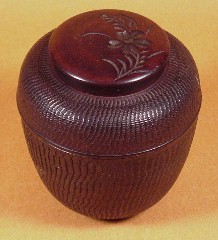 Most of the boxes have some sort of lathe chatter, on the sides and/or on the top.
Lathe chatter, also called harmonic chatter, results when the lathe tool is vibrating and
cutting into the wood in an up and down pattern.
This results in a textured pattern which is pleasing to the eye in its
combination of randomness and regularity.
If you look directly at the pattern, it looks as if it were carved by hand.
If you hold it to the light, looking across the texturing, you can clearly see the round lathe marks.
Most of the boxes have some sort of lathe chatter, on the sides and/or on the top.
Lathe chatter, also called harmonic chatter, results when the lathe tool is vibrating and
cutting into the wood in an up and down pattern.
This results in a textured pattern which is pleasing to the eye in its
combination of randomness and regularity.
If you look directly at the pattern, it looks as if it were carved by hand.
If you hold it to the light, looking across the texturing, you can clearly see the round lathe marks.
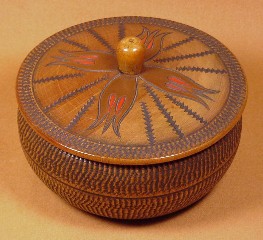 To modern wood turners, lathe chatter is a beginner's mistake and something to be avoided.
If it is to be used at all, it is usually only attempted in the end grain of the wood,
(i.e. the top of the boxes), because it is very difficult to control.
For the Japanese craftsmen who made these boxes to make such extensive use of this design element,
both in the end grain and in the side grain, is an amazing accomplishment.
To modern wood turners, lathe chatter is a beginner's mistake and something to be avoided.
If it is to be used at all, it is usually only attempted in the end grain of the wood,
(i.e. the top of the boxes), because it is very difficult to control.
For the Japanese craftsmen who made these boxes to make such extensive use of this design element,
both in the end grain and in the side grain, is an amazing accomplishment.
| Line Carving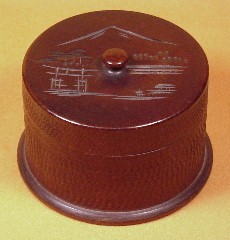 Almost every box has got a style of carving which we call "line carving".
This is not relief carving where an attempt is made to present the image in three dimensions.
Rather, carved lines are used like pencil strokes in a drawing.
The carvings usually take the form of one of the recurring themes or set patterns.
This is fairly common in most "folk arts", where the artisans and craftsmen who are
producing the work don't view themselves as artists.
Almost every box has got a style of carving which we call "line carving".
This is not relief carving where an attempt is made to present the image in three dimensions.
Rather, carved lines are used like pencil strokes in a drawing.
The carvings usually take the form of one of the recurring themes or set patterns.
This is fairly common in most "folk arts", where the artisans and craftsmen who are
producing the work don't view themselves as artists.

The recurring themes include:
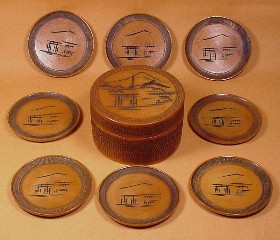
Occasionally, as on the coaster set to the left, the carved lines will be darker than the surrounding wood surface. This was sometimes done by woodburning, and sometimes done by filling the carved lines with a paste stain and rubbing the stain off of the higher surfaces, leaving the recessed areas dark. When woodburning was used, a faint shadow of the design is often visible on the opposite surface of the wood.
| Paint or Lacquer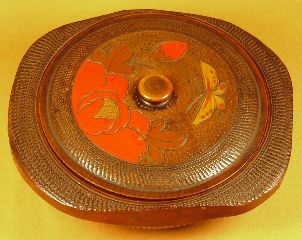 Sometimes areas defined by the carved or woodburned lines are painted, usually in solid colors,
but sometimes with some painted details as in this butterfly.
Sometimes areas defined by the carved or woodburned lines are painted, usually in solid colors,
but sometimes with some painted details as in this butterfly.
| Wood Veneer Inlay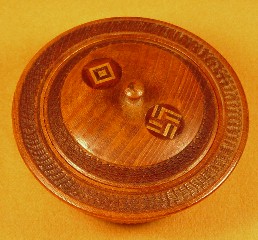 The lids of a few boxes we've seen have some small, and very precise, wood inlays, in
geometric symmetrical patterns.
The lids of a few boxes we've seen have some small, and very precise, wood inlays, in
geometric symmetrical patterns.
| |